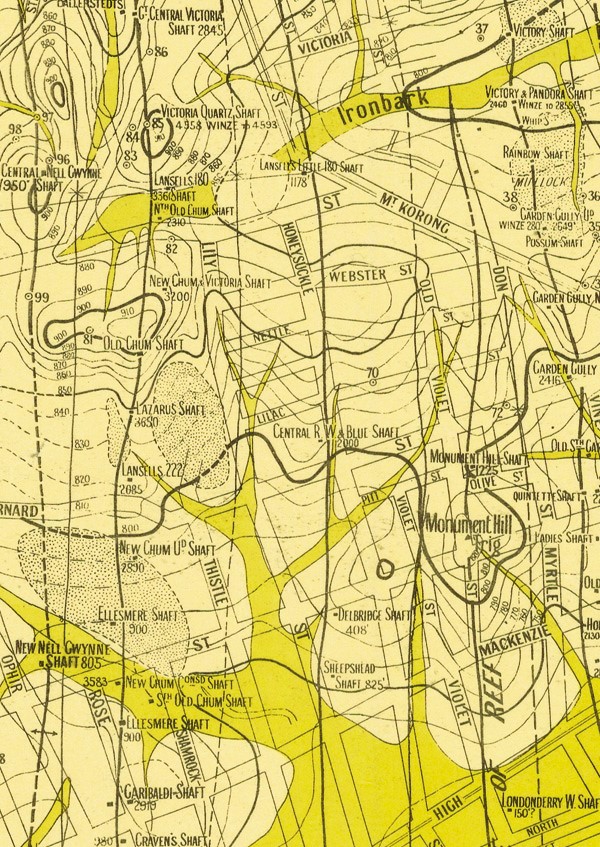MAY 2019 (1) BENDIGO GOLD
The first gold rushes of the Australian colonies began in May of 1851 with the finding of gold at Ophir in NSW. With active encouragement from government (an early form of FOMO?) Victoria followed suit in July of that year, with gold finds at Clunes, closely followed by ones near Ballarat.
In November of 1851, the first alluvial gold was found in the Bendigo Creek. By mid-1852, there were some 20,000 miners seeking their fortunes in the area.
Although the Eureka Stockade Rebellion of 1854 ensured the focus of our gold history has been on Ballarat, Bendigo was in fact a much more significant mining area. Between 1851 and 1954, on today’s prices, the Bendigo mines yielded about $65 billion worth of gold. Given the current parlous state of the Victorian economy there must have been some pretty inept financial planning over the years…

The NW-SE alignment of reefs is evident
By 1855, the more easily found near-surface alluvial gold was petering out. Mining shifted underground, following rich quartz reefs. Of necessity, the individual alluvial miners were mostly replaced by companies that could afford the necessary outlay for the equipment needed.
The mined 37 parallel Bendigo reefs extended under an area roughly 16kms, in a NW-SE direction by 4kms across. Over 5000 shafts were sunk across that area. Bendigo came to have the largest concentration of deep shafts in the world at the time, with the deepest over 1km down.

Once were mine locations – now part of Bendigo urban area
Chinese miners were among the first rushes to the area that would become Bendigo, flocking to Dai Gum San, as they termed it – Big Gold Mountain.
By the 1880’s Bendigo was regarded as the richest city in the world, due to the amount of gold that had been found here. The grand buildings of the new city reflected this wealth.
The last major mine ceased operation in 1954 and it seemed that the golden days of the Bendigo area were done. But the gold was not exhausted. Improving mining and exploration technology and the rising price of gold led to the revival of large scale mining – the Fosterville mine to the NE of the city – from 2006.
Recently there has been a surge in exploration for gold in the area between Bendigo and the Murray valley. For decades, it had been assumed that the rich Bendigo reefs petered out to the north. Now it has been found that some of those reefs continued, but deeper and buried under the sediments of the riverine plains.
Visitors to modern Bendigo can explore plenty of remnants and relics of the historic gold mining. The Central Deborah Mine, on the edge of the modern CBD, preserves an historic mine largely as it was, both the associated surface structures as well as the mine itself. One can, if so inclined, take a tour down this mine, to a depth of more than 200 metres. It is now also a terminus for the historic tram tour of Bendigo.

Central Deborah mine today
Less formally, (and on top of the ground) there are many locations around the city and surrounding area that signal its history. One becomes accustomed to the appearance of an old poppet head glimpsed between the modern industrial buildings of today’s Deborah Triangle, or behind a row of suburban houses; to the many areas of undeveloped land scattered through the modern suburbs, where development simply jumped areas of mining or mullock heaps. The occasional large mullock hill has been sprayed a green colour that is never found in nature, to denote heavily contaminated soil.

Spot the poppet head – Deborah Triangle area
The legacy lives on, too, in place names that evoke the way the city developed. Specimen Hill. Golden Gully. Long Gully. California Gully, Sailors Gully, Golden Square, Jackass Flat.




